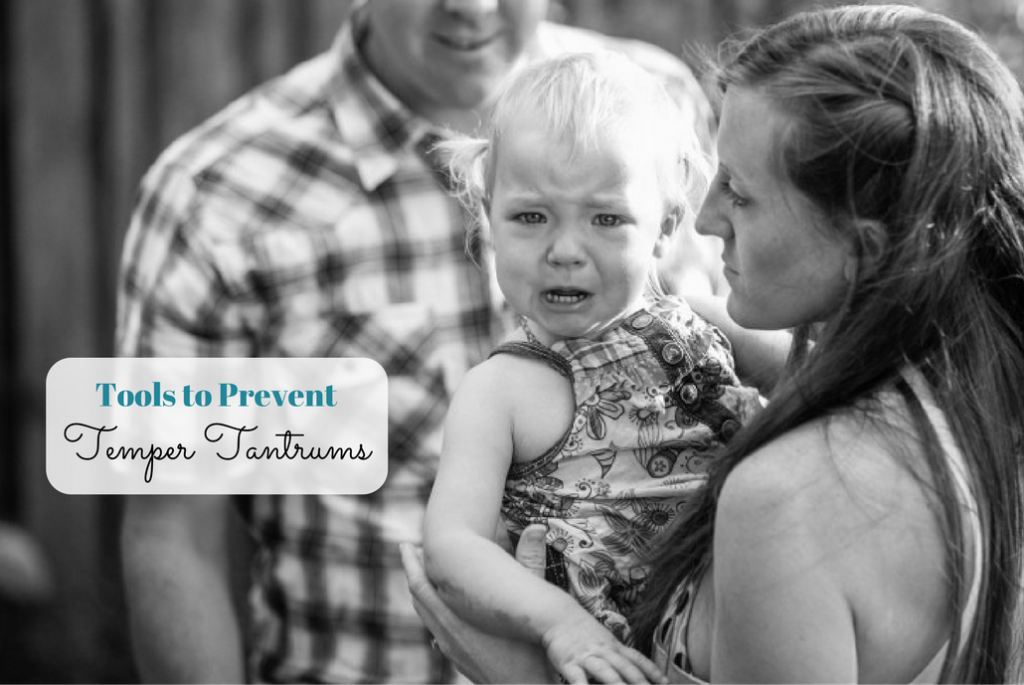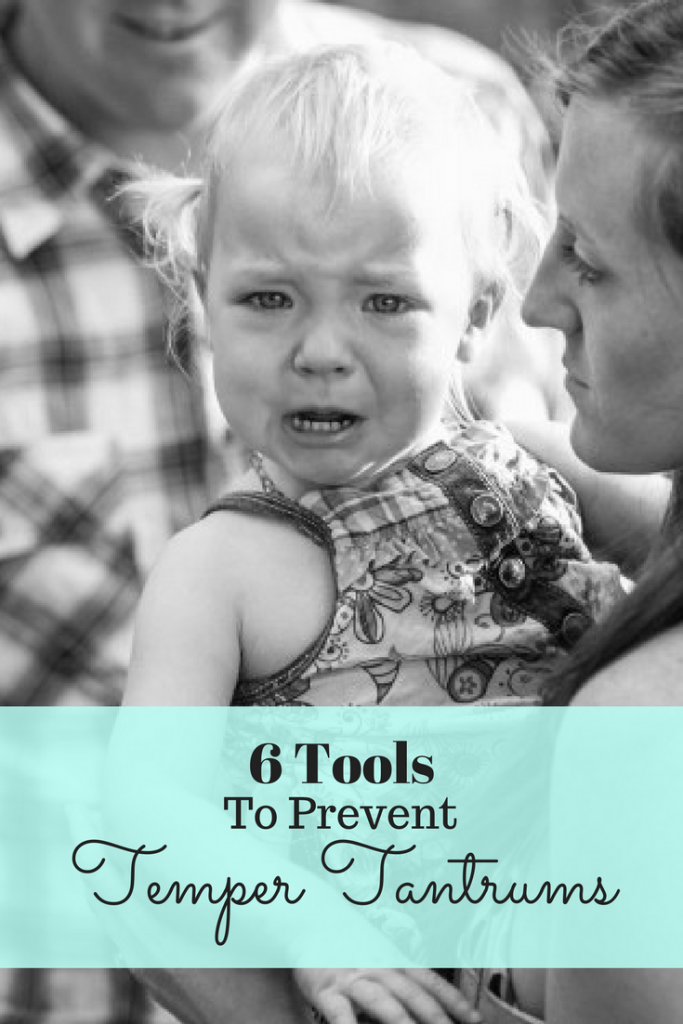
Temper tantrums. Every parent will have the (dis)pleasure of helping their child move through these emotionally-charged events, No matter how skilled a caregiver is, once a child has fallen down the rabbit hole of intense feelings into a temper tantrum, it can be hard to help them regain composure.

Because of the way that our brains work (or rather don’t) when we have crossed the threshold of managing our emotions, a tantrum is not the best time for learning lessons. We can only do our best to help our littles regain control of themselves, and show them that we are there for them.
It’s helpful to have an imaginary tool belt full of ideas to keep abreast of the parenting predicaments we find ourselves in. The more ideas we gather, the more tools we have to keep our days flowing along without too many bumps. While not every tantrum will be preventable, here are some things to consider to help in preventing temper tantrums.
If you’ve ever been “hangry” you know how hopeless and miserable you can be to yourself and the people around you. Keeping our children energized with healthy food throughout the day is important to managing everyone’s mood. The first thing I tend to consider when I notice my little whining or acting out is “Are you hungry?” When I ask this question out loud, I am often responded to with an enthusiastic “Yes!”.
Remember, our children are newly discovering their bodies, and they may not even recognize how hungry they are until we help to bring their attention to it. By paying close attention to when and what your children are eating, and keeping healthy snacks on hand for when energy levels dip, can make a huge impact on everyone’s mood and behaviours. (This goes for us adults, too. We’re much more level-headed caregivers when we’re not fighting our “hanger”.)
A little forward thinking goes a long way. If you’re going to be entering a situation and want things to go a certain way, consider the possibilities. For instance, if you’re going to the supermarket, and have no time to stop at your child’s favourite park, which you’ll pass on your way, consider how you’ll deal with your child’s impending frustration at not being able to play there. Is there another route you could take, that doesn’t pass the park? Will you be able to leave a bit earlier than planned to allow your child a brief play there? Is there something else your child can look forward to when the shopping is over?
By considering what’s going to happen, recognizing what might be a trigger for a tantrum, and coming up with potential solutions ahead of time, you’re much better able to avoid that tantrum.

You’ve asked your child not to touch the breakable object that’s in front of them, yet they keep going for it and lose their temper when you just won’t let them have it. Instead of exasperatedly asking “Why won’t you listen?!”, ask yourself why it’s there in the first place.
Children have strong impulses, which is an important part of the driving force to learn about themselves and their world. Often we ask a lot more of them than they are capable of complying with. Instead of constantly entering into a battle of wills, carefully consider how you could alter your environment to encourage appropriate behaviour. Sometimes we do need to be in space we cannot change, but when it’s possible, arrange furniture, place items in new positions, cover or block distractions, or otherwise set up your environment to make everyone’s life easier.
Don’t get me wrong. “No” is an important word to understand. “Don’t” is something that should be heeded. However, when we focus on telling a child what not to do, we leave them no direction for what they can do. Often children will do exactly the opposite of what we’ve said not to do, because that’s the only clear option we’ve given them (even if we said not to choose it).
Every time you want to say “no” or “don’t”, try to come up with a phrasing that offers an appropriate way to act. For instance, instead of saying “Don’t pull the cat’s tail!”, try saying something like “We can pet cats gently like this…” (demonstrating how to pet a cat).
For more information about this strategy, you can read this post about how to get toddlers to listen to your words.
As adults who have been around for a while, we have the ability to infer meanings and reasons from very few (if any) directions. Children need more support to understand what is expected of them. When we clearly share our expectations for behaviour with our children, they are better able to comply. For example, “Stay there” might seem perfectly understandable to us, but a young child may need more specific direction. “Keep your feet on the red square” does a much better job of communicating what they should do.
Be as specific as possible, while trying to keep your sentences short. You can help to ensure that they heard and understand your instructions by asking them to repeat back to you your expectations.
Why would you choose to do (or not do) something you disagree with, when there seems to be no reason to? It’s important for children to learn to listen to what we say, as we have their best interests at heart. But unless we share our reasoning behind our directions, how can they see that we’re coming from a place of caring?
When giving those clear and specific directions, make sure to share an explanation of why. Not only will this show that you want to keep everyone safe and comfortable, but it will also help them learn how to consider consequences and make good decisions for themselves.
When you set and enforce rules, do so with empathy. By showing children that you can understand and sympathize with their situation and feelings, you create a positive environment where trust and mutual respect can flourish. To learn more about the why’s and how’s of parenting with empathy, you can read this post with helpful strategies for disciplining with empathy.

Once a child becomes engulfed in their emotions to the point of a tantrum, they cannot function reasonably. Again, this is not the time to teach a lesson, but rather to calm everyone down. I will have some tips for taming tantrums for you coming up soon on Green Moms Collective. Watch for it there, and I will link to it here when the post is live.
Good luck out there, folks! I’m rooting for you!
If you found something useful here, you might consider signing up here for a short and sweet email from time to time. It will let you know if I post any awesome new stuff like this. (And we get some great giveaways, too!) You could also catch up with me on Facebook, Twitter, Instagram, or Pinterest.
3 thoughts on “Preventing Temper Tantrums: 6 Tools To Help Young Kids Keep Their Cool”
Lovely! I took responsibility for nearly all of my daughter’s meltdowns when she was a toddler. She was such an easy going kid that when she did lose it, it was usually a result of me over-extending her. She was tired or hungry. If I responded with empathy and cuddles, (and 98% of the time, numnums – her word for nursing), she would be calm and asleep in moments.
It’s amazing what a little bit of empathy can do! Thanks for commenting, Lizzie!
Pingback: Tips for Taming Temper Tantrums Respectfully - The Big To-Do List